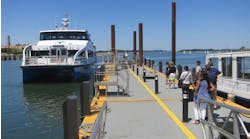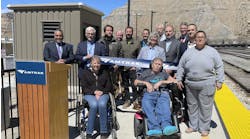It is one of the oddities of America that it needs a film like this. America once had the biggest passenger railroad network in the world and its most prosperous railway industry but this has mostly been forgotten as the car has become the dominant form of travel since World War Two.
In an act of short-sightedness, the passenger railroad was all but shut down in a remarkably short period in the first 25 years after the War, and only the creation of a federally-owned company, Amtrak, saved it from total extinction. All that is left now are regular services on the East Coast corridor, commuter trains in a few cities, notably New York and Chicago, and long distance trains extending in all but a couple of states. Vast swathes of the country, and whole big cities have no long distance or local rail service for passengers.
This delightful film, Trainsforming America, seeks to remedy that by portraying the contrast between Europe an America. It interweaves between the two showing people in Europe for whom driving, rather than using transit, is the norm. The very fact that a film has to illustrate what to us Europeans is a banality shows how distant America is from becoming a country where hopping on a train is as commonplace as dropping into a MacDonald’s. This film is a basic primer on why trains are wonderful and, oddly, how to use them.
The film forcefully demonstrates why America should let the train take the strain again. People who use transit are likely to be fitter and healthier than those who jump in their cars and barely walk all day, according to one of the films contributors, an NYU professor. He demonstrates the frightening extent of the obesity crisis which is frightening and yet it is very clear, as any visitor to New York will notice, that cities with high levels of transit use have fewer fat people.
There are other reasons, too. One young American woman who lives in Italy says one of the pleasures of not travelling by car is that one is more likely to meet and greet people on the streets, whereas in a car she feels separated from those in the other ‘boxes’ around her. There is, too, the advantage today of being able to use the laptop and the mobile phone while travelling, or indulging in the old fashioned pleasure of reading.
There is one big gap in the film. America actually still has the largest network in the world, around 95,000 miles of track. They are mostly, of course, for have freight trains which remain highly profitable and ubiquitous, trundling through most cities and vast swathes of the country but the film ignores them, just as for the most part the American people also do. Indeed, one of the biggest barriers to the rail renaissance which this film hopes to stimulate is how to accommodate both the burgeoning rail freight industry and a host of new passenger trains. It was the closure of passenger services and the deregulation of the freight industry that made the industry profitable and eventually freestanding once again. The freight companies will not want to see a big increase of passenger returning to their network.
One solution would be, as some of the contributors to the film suggest, a whole new network of high speed lines, funded by federal government as the Interstate highways were when they were built in the 1950s and 1960s. The question is, will America, which has lost the train habit, ever be convinced to put up the money for such a scheme? The winds are changing, says one High Speed Rail advocate, but are they changing fast enough?
Christian Wolmar is the author of The Great Railroad Revolution, the history of American railroads, published by PublicAffairs.


